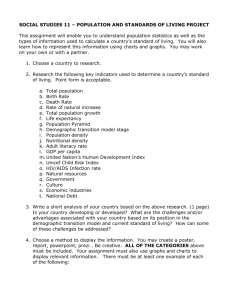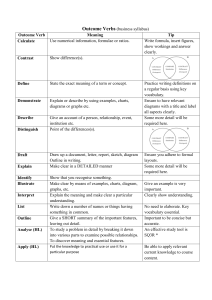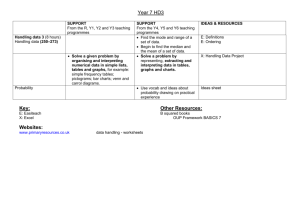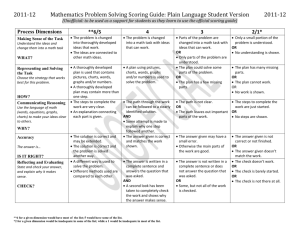Writing up your undergraduate dissertation
advertisement
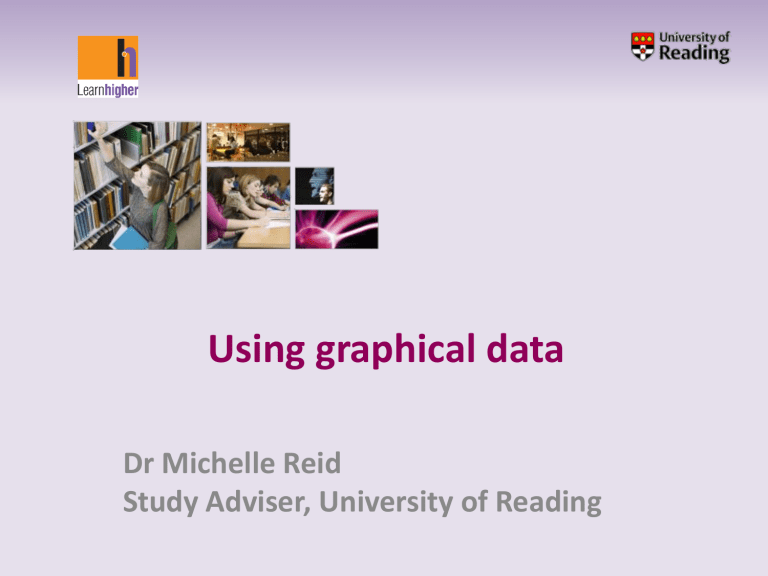
Using graphical data Dr Michelle Reid Study Adviser, University of Reading Overview of the workshop • Why use graphical data? • Tables, graphs, diagrams, pictures • What to remember when using graphical data To start you thinking… Who writes reports? Working in pairs: • List as many different kinds of reports as you can (e.g. Reports on lab work, reports on field work) A prize for the longest list! Why use graphical data? • Shows information in an easy to understand visual form • Adds value – conveys something more than just writing can • Helps the reader see trends, patterns, or complex processes more easily • Is accurate, relevant, and clear – and has a purpose Referring to graphical data • If you include a figure or table, you should always refer to it and explain what it shows: e.g. “The Keeling plant's production capacity was reached in May this year. In contrast, the Hergort plant has not yet reached 75% of its production capacity (see Table 13)”. • Label your figures clearly – figure 1, figure 2, etc • Make it clear to your audience which one you are referring to Main types of graphical data • Tables • Bar charts • Line graphs • Pie charts • Drawings / diagrams • Photographs Tables are useful for… • Presenting a quantity of numerical data in an accessible format • Showing exact numbers Using tables • If you have a lot of data in tables – are they all essential? Can some be placed in an appendix? • Make sure your columns and rows are clearly labeled • Tables can rarely stand alone – you need to describe in words what the table shows – what are the key things the reader should look for? • Graphs may be better for showing trends or patterns Bar charts are useful for… • Comparing discrete values or categories • Comparing a number of different discrete values side by side (see fig.2) Internet use by Redwood School students 1995-2002 Figure 1 Figure 2 (From Statistics Canada) Using bar charts • Bars can be vertical or horizontal (horizontal is sometimes best if there are a lot of categories) • Use of colours can help distinguish between the bars • Bar charts are not as effective as line graphs at showing continuous increasing / decreasing trends Line graphs are useful for… • Showing trends (how data changes over time) • Showing relationships (how two variables interact) Using line graphs • Check that your values for the x-axis (horizontal) and the y-axis (vertical) are correct • When plotting trends over time, the x axis is commonly used to represent units of time, and the y axis is used to represent quantity • Use a sensible scale so that the line’s shape does not give the audience an incorrect impression of the data Line graph scales Number of guilty crime offenders, Grishamville, 2007 Figure 1 Which scale gives the most accurate view of the trend in offender reduction? Figure 2 Graphs from Statistics Canada www.statcan.gc.ca Pie charts are useful for… • Showing the percentage or proportion of the whole that is taken by various parts • percent ÷ 100 x 360 degrees = the number of degrees Using pie charts • Put the %s in as numbers alongside the segments for ease of reading • The chart can become difficult to read if there are too many segments • Avoid using a pie chart if you have a lot of small % which are very similar – the segments will be hard to distinguish • When comparing two sets of data (e.g. figures for boys and girls) use a double bar graph, as comparing segments across two separate pie charts is difficult Drawings / diagrams are useful for… • Showing complex processes or detailed technical descriptions • Showing a step-by-step cycle or process (e.g. in manufacturing) Diagram by Eric Pierce Using drawings / diagrams • Make sure all your diagrams are large enough and of sufficiently high quality • Label and explain each diagram fully • Reference any diagrams / figures that have been created by another person Photographs are useful for… • Illustrating what is being described • As visual evidence (e.g. showing a particular site, scene or landscape) • When you need “real world” visual evidence, that can’t easily be drawn Photo by K. Kiser Using photographs • It is tempting to include photos just to make your report look nice! Always think - what is the purpose of this photo and what would happen if it wasn’t there? • Reference all photos taken by another person • You may still have to ask permission to use your own photos if your work is likely to be published (e.g. if it is of people or a private building etc) • Check the quality, especially if you are printing colour photos in black and white Activity: What’s wrong with this picture? Working in small groups – each group has a different image / graph Assess the use of graphical data – is your figure: • • • • Appropriate Clearly labelled Accurate The right scale Why has this form of graphical data been chosen? What to remember when using graphical data Is this necessary, or just decorative? Have you double checked the data for accuracy? Is the type of figure (graph / table / diagram) appropriate for its purpose? Is the figure labelled clearly with a title? Does it have a key if necessary? Is the figure of sufficient size and quality to be easily interpreted? Do you describe what the figure shows in words too? Have you referenced all figures created by other people? Further resources LearnHigher report writing webpages www.learnhigher.ac.uk/learningareas/reportwriting/home.htm Guides and exercises on all aspects of reports. Analyse this! (Manchester Metropolitan) www.learnhigher.ac.uk/analysethis/ Simple and accessible guide to data analysis Any questions? Thank you and good luck with your report writing!

